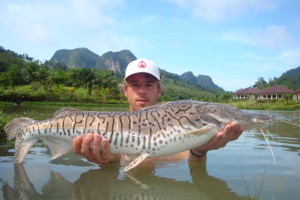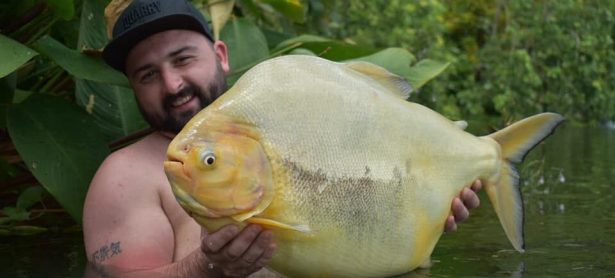 Name: Tiger catfish (sorubim barred).
Name: Tiger catfish (sorubim barred).
Species: Pseudoplatystoma fasciatum.
Thai name: Pla sira.
Max length: 1.5m.
Max weight: 60kg.
IGFA record: 35lbs.10ozs-16.17kgs.
Diet: Fish, squid, frogs, earthworms, crustaceans, shrimp.
To fish for our tiger catfish we recommend you use small sea fish deadbaits or squid fished on the bottom, in the margins and tight to the water hyacinth beds. The best times to target these fish is the first two hours of darkness. For hooklinks we recommend soft braids in 60lb bs fished in conjunction with size 1/0 ultra sharp hooks. Expect takes to be savage and fast, and these beautifully marked fish fight hard and deep, making repeated long, hard runs.
They give their all in the fight, and for this reason must be given time to recover. When handling these fish be aware they have sharp pectoral and dorsal fins, which can inflict a nasty spike to you. Other than these features there are no other parts to worry about, and they do not posses teeth – as with most catfish they just have tough pads in their mouths.
General facts on the Tiger Catfish:
Tiger catfish are also known as shovel nosed tiger catfish and striped sorubim. As with many species in Thailand they were introduced here for the aquarium trade. The tiger catfish has a depressed head that is usually three times longer than it is wide. They are characterized by a shovel like projecting jaw with an exposed brush-like patch of teeth. The eyes of the tiger catfish are set to enable them to see up and down, and coupled with extremely long whiskers they are adept at hunting out food items in all conditions. Their bodies are silver with vivid black stripes, and they change shades of colour to suit the environment they live in.
They also have a characteristic black lateral stripe, variable in width, that reaches from their snout and along the entire length of their body. No other member of the catfish family posses this feature. They have distinct speckled fins, which together with their stripes make perfect camouflage for hiding in weedbeds to ambush their prey. The tiger catfish originates from the Americas where they are distributed in ten countries between the Amazon, Orinoco, and Parana and Paraiba river basins. These catfish will not breed in still water; they need a sandy bottom in moving water. They are thought to build a nest and protect their young. Their spawning times are set more by non-flood conditions than particular times of the year.



































































